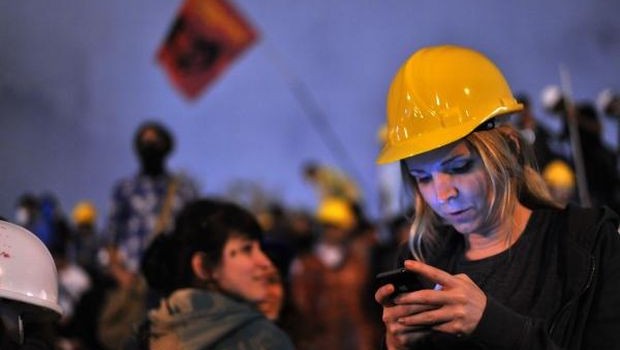The unprecedented wave of nationwide mass demonstrations in the Arab world, subsequently labeled as the “Arab Spring,” took people by surprise. These spontaneous, massive protests not only succeeded in toppling four Arab heads of state and continue to challenge others in the region but, more importantly, are paving the way for a new political order in the Middle East. Despite the initial assumption that these massive demonstrations would be confined to the Arab world, given the exceptional deficiency in democratic governance in the region, it is becoming increasingly apparent that this phenomenon of “popular empowerment” has stretched far beyond the boundaries of the Arab world in the past two years, and for reasons that do not necessarily coincide with those that sparked the “Arab Spring.”
In Turkey, thousands took to the streets in Taksim Square in protest at what they felt was a gradual imposition of religious values on their secular state. In Brazil, thousands flooded numerous cities across the country demanding better education, healthcare, and additional anti-corruption measures. In Nigeria, nationwide protests led by the protest movement Occupy Nigeria erupted in the biggest cities in response to the removal of fuel subsidy by the Federal Government. In Greece, thousands of people protested against plans to cut public spending and raise taxes as austerity measures. In Bulgaria, unprecedented waves of protest rallies took place against the government for soaring utility bills, corruption, and lack of transparency. The list of countries which witnessed nationwide protests is long.
Despite the differences in motives, magnitude, and outcomes of these nationwide demonstrations, and notwithstanding the disparities in democratic governance and economic performance among these nations, they all nevertheless share a common feature: the increasing readiness of citizens across the globe to mobilize on a significant scale to challenge authority and impose change. Even though each of these national demonstrations were responding to diverse local grievances, it would be misleading to see them as detached events isolated from a greater global pattern. The protests were not merely the outcome of societal frustrations accumulated over years. Nor were they simply a product of the ever-growing influence and dependency on social media for collective activism. Nationwide demonstrations across the globe question the efficacy and suitability of contemporary governance structures, and emphasize the need for structural political reform in a way that brings government closer to people, rather than distancing them. At the core of these demonstrations is an outcry against the failure of the authorities to adapt to the new world.
Despite the fundamental transformation in global politics in the last two decades, where the traditional state-centric system was gradually replaced with a decentralized, globalized political order, governance structures in many countries around the world did not sufficiently adapt nor reform to reflect this new structural dynamic. Whereas the world became more decentralized, interconnected, and fast-paced, many governments across the globe remained centralized, bureaucratic, and inflexible. As a result, the gap between governments and people—especially in the Third World—widened steadily and governments have found difficulty in meeting the rising expectations of their people. Political organizations and governance structures continue to operate in a traditional mode, stifling innovation and efficacy which have evolved as the key features of the new world. In a globalized world where citizens are continuously subject to endless flow of information and are increasingly cognizant of their civil and constitutional rights, conventional approaches to governance will hardly satisfy the minimal expectations of people.
The challenges facing societal stability in several parts of the globe are growing and so has the inclination to confront authority. The world has changed, but the approach to governance has not. Societies have become highly observant and cognizant communities, while many governments remain entrenched in a conservative mindset, unable to adjust to the tempo and dynamism of the unfolding order of this new world. In many ways, several governments are operating like outdated computer software. They may function, but their modus operandi can no longer adapt to new and sophisticated developments in their surroundings. If governance structures are not reformed in a way to adjust to rapidly changing societies, public turbulence will continue. Reform should entail creative structural changes that guarantee more communication between governments and their people, efficiency in delivering public services, and greater transparency in policymaking bodies with participation from civil society, domestic constituencies, and stakeholders.
Narrowing the gap between those “governing” and the “governed” will perhaps become one of the toughest challenges facing future leaders. In an increasingly hyper-connected world where the flow of information is uncontrollable and societal anxieties are increasing at an alarming rate, many governments will continue to face societal unrest in the form of nationwide demonstrations challenging those in power. Without injecting creative changes in both the political and structural organization of governments to adapt to the transformative changes in societies and to assist executive branches exercise good governance, governments will continue to lag behind their people. For now, however, it seems likely that the trend of global nationwide demonstrations will not subside. In fact, it will broaden.
